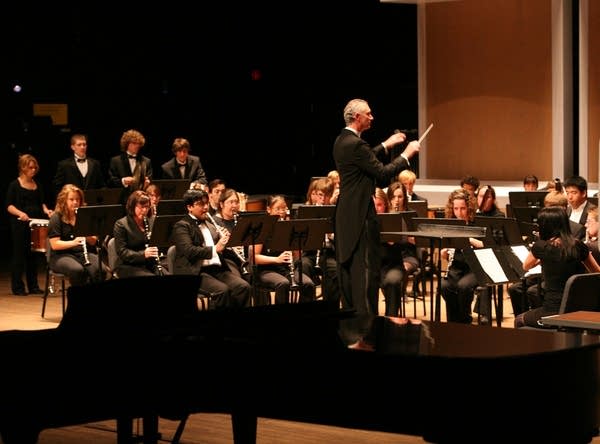
It's time to go back to school, and thousands of Minnesota children and young adults will dust off their instruments and start learning new music — especially in band.
Call it wind band, wind ensemble, concert band — however you choose to name it, there is a ton of music written for wind groups. Today, you'll hear some of the most famous, and some of the most influential, band music.
Let's get started with one of the best: composer Gustav Holst.
Holst wrote one of the most famous pieces for wind band because he thought there wasn't any good music for bands. Since he was a trombone player, he played a lot of band music, particularly in English brass bands, and he wanted to fill a void by writing something great for wind band.
He wrote this — his First Suite for Band — in 1909.
You'll recognize other famous composers who contributed to wind music in some way or another. Some surprises are around the corner, including music from one man who advanced wind instruments in innovative ... and odd ... ways.
Here's another sample from the English brass band tradition that comes from a man who taught Gustav Holst composition lessons and then they became pretty great friends — Ralph Vaughan Williams. Here's a piece by Vaughan Williams from the 1920s called English Folk Song Suite.
Leading up to this piece and the Holst, both Hector Berlioz and Richard Wagner contributed to the importance of wind instruments.
Hector Berlioz wrote a really famous book to help composers understand how to write for specific instruments. It's called Treatise on Instrumentation, and Berlioz explains things such as how high a flute can comfortably play, what kinds of things to avoid when writing for French horn, and lots of other things handy for composers to know.
In fact, the fourth and final symphony Berlioz wrote in 1840 is for a large wind band, but there are also winds and strings.
Hector Berlioz called his Symphony No. 4 Grand Funeral and Triumphal Symphony — and although there are strings and there's a chorus involved, too, the cool thing about that symphony is the large number of wind players he included.
Richard Wagner went so far as to invent a new brass instrument for his operas, and he wrote a piece for band, too. This is Trauermusik.
We've talked about two English composers, Gustav Holst and Ralph Vaughan Williams. We heard from Berlioz, who was French, and the German, Richard Wagner. But band is so American.
So, where are the Americans? Well, Aaron Copland wrote a piece or two for wind ensemble: one piece called Emblems, and another that he wrote for either student orchestra or band, Outdoor Overture.
About a decade later (now we're in the 1940s), Igor Stravinsky threw his hat in the ring — and it's interesting because Stravinsky wrote this piece to memorialize a composer who never wrote for wind band his entire career — Claude Debussy. This is a piece for winds by Stravinsky called Symphonies of Wind Instruments.
Occasionally, wind bands borrow straight from the classical repertoire.
One such piece comes from Dmitri Shostakovich, a piece called Festive Overture originally written in the '50s to celebrate the Bolshevik Revolution; given the political climate, this is lighter than a lot of his music.
Here's another piece that works well for wind band, borrowed from the orchestral repertoire: It's Johann Sebastian Bach's Fantasia in G:
Concert bands started popping up in America like crazy in the middle part of the 20th century. This inspired composers like Paul Hindemith, Arnold Schoenberg, Vincent Persichetti and Darius Milhaud to write music. It also helped usher in a new generation of composers who chose to focus on writing for wind ensembles, like David Maslanka and Frank Ticheli.
Here is one of Ticheli's most famous pieces for wind band - called Blue Shades.
Another famous wind ensemble composer is David Maslanka. He's written nine symphonies for wind band and dozens of other works for that make-up; this is his Fourth.
There are so many aspects of band music left to explore, like the influence of military band and the hundreds of marches by Karl King and John Philip Sousa.
Such as:
Other significant band composers include Percy Grainger, Paul Hindemith, Ron Nelson, John Zdechlik, Joseph Schwantner and many, many more.
Next week on Learning to Listen, a famous composition teacher has a birthday — we'll hear music from Nadia Boulanger and her students as well, and find out why she was so influential.
Learning to Listen — a new series from Classical MPR, hosted by Emily Reese — is an hour of music devoted to exploring classical music for learning and appreciation. Each week we'll take a topic, a composer, an era, a genre or a single piece and learn more about it — and then we'll listen.
Love the music?
Show your support by making a gift to YourClassical.
Each day, we’re here for you with thoughtful streams that set the tone for your day – not to mention the stories and programs that inspire you to new discovery and help you explore the music you love.
YourClassical is available for free, because we are listener-supported public media. Take a moment to make your gift today.


